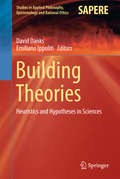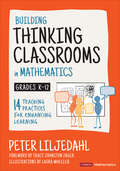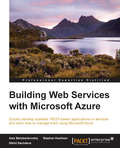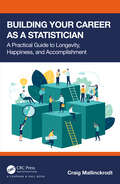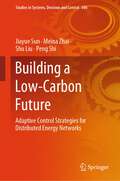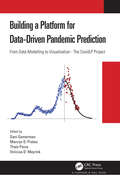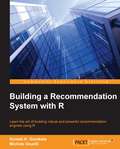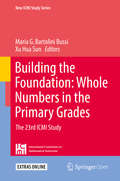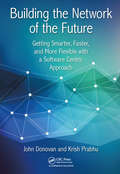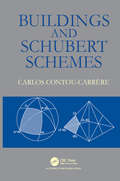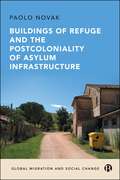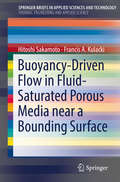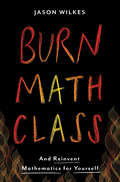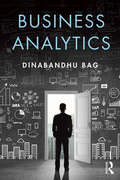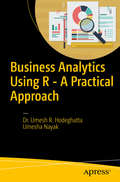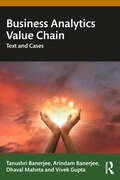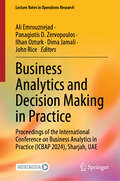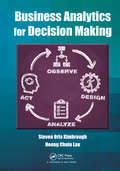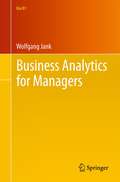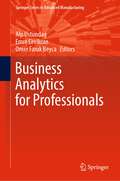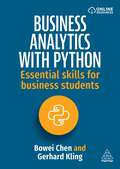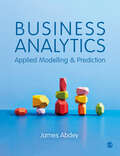- Table View
- List View
Building Theories: Heuristics and Hypotheses in Sciences (Studies in Applied Philosophy, Epistemology and Rational Ethics #41)
by Emiliano Ippoliti David DanksThis book explores new findings on the long-neglected topic of theory construction and discovery, and challenges the orthodox, current division of scientific development into discrete stages: the stage of generation of new hypotheses; the stage of collection of relevant data; the stage of justification of possible theories; and the final stage of selection from among equally confirmed theories. The chapters, written by leading researchers, offer an interdisciplinary perspective on various aspects of the processes by which theories rationally should, and descriptively are, built. They address issues such as the role of problem-solving and heuristic reasoning in theory-building; how inferences and models shape the pursuit of scientific knowledge; the relation between problem-solving and scientific discovery; the relative values of the syntactic, semantic, and pragmatic view of theories in understanding theory construction; and the relation between ampliative inferences, heuristic reasoning, and models as a means for building new theories and knowledge. Through detailed arguments and examinations, the volume collectively challenges the orthodox view's main tenets by characterizing the ways in which the different "stages" are logically, temporally, and psychologically intertwined. As a group, the chapters provide several attempts to answer long-standing questions about the possibility of a unified conceptual framework for building theories and formulating hypotheses.
Building Thinking Classrooms in Mathematics, Grades K-12: 14 Teaching Practices for Enhancing Learning (Corwin Mathematics Series)
by Peter LiljedahlA thinking student is an engaged student Teachers often find it difficult to implement lessons that help students go beyond rote memorization and repetitive calculations. In fact, institutional norms and habits that permeate all classrooms can actually be enabling "non-thinking" student behavior. Sparked by observing teachers struggle to implement rich mathematics tasks to engage students in deep thinking, Peter Liljedahl has translated his 15 years of research into this practical guide on how to move toward a thinking classroom. Building Thinking Classrooms in Mathematics, Grades K–12 helps teachers implement 14 optimal practices for thinking that create an ideal setting for deep mathematics learning to occur. This guide Provides the what, why, and how of each practice and answers teachers’ most frequently asked questions Includes firsthand accounts of how these practices foster thinking through teacher and student interviews and student work samples Offers a plethora of macro moves, micro moves, and rich tasks to get started Organizes the 14 practices into four toolkits that can be implemented in order and built on throughout the year When combined, these unique research-based practices create the optimal conditions for learner-centered, student-owned deep mathematical thinking and learning, and have the power to transform mathematics classrooms like never before.
Building Thinking Classrooms in Mathematics, Grades K-12: 14 Teaching Practices for Enhancing Learning (Corwin Mathematics Series)
by Peter LiljedahlA thinking student is an engaged student Teachers often find it difficult to implement lessons that help students go beyond rote memorization and repetitive calculations. In fact, institutional norms and habits that permeate all classrooms can actually be enabling "non-thinking" student behavior. Sparked by observing teachers struggle to implement rich mathematics tasks to engage students in deep thinking, Peter Liljedahl has translated his 15 years of research into this practical guide on how to move toward a thinking classroom. Building Thinking Classrooms in Mathematics, Grades K–12 helps teachers implement 14 optimal practices for thinking that create an ideal setting for deep mathematics learning to occur. This guide Provides the what, why, and how of each practice and answers teachers’ most frequently asked questions Includes firsthand accounts of how these practices foster thinking through teacher and student interviews and student work samples Offers a plethora of macro moves, micro moves, and rich tasks to get started Organizes the 14 practices into four toolkits that can be implemented in order and built on throughout the year When combined, these unique research-based practices create the optimal conditions for learner-centered, student-owned deep mathematical thinking and learning, and have the power to transform mathematics classrooms like never before.
Building Web Services with Microsoft Azure
by Alex Belotserkovskiy Stephen KaufmanIf you are a .NET developer who wants to develop end-to-end RESTful applications in the cloud, then this book is for you. A working knowledge of C# will help you get the most out of this book.
Building Your Career as a Statistician: A Practical Guide to Longevity, Happiness, and Accomplishment
by Craig MallinckrodtThis book is intended for anyone who is considering a career in statistics or a related field, or those at any point in their career with sufficient work time remaining such that investing in additional learning could be beneficial. As such, the book would be suitable for anyone pursing an MS or PhD in statistics or those already working in statistics. The book focuses on the non-statistical aspects of being a statistician that are crucial for success. These factors include 1) productivity and prioritization, 2) innovation and creativity, 3) communication, 4) critical thinking and decisions under uncertainty, 5) influence and leadership, 6) working relationships, and 7) career planning and continued learning. Each of these chapters includes sections on foundational principles and a section on putting those principles into practice. Connections between these individual skills are emphasized such that the reader can appreciate how the skills build upon each other leading to a whole that is greater than the sum of its parts. By including the individual perspectives from other experts on the fundamental principles and their application, readers will have a well-rounded view on how to build upon and fully leverage their technical skills in statistics. The primary audience for the book is large and diverse. It will be useful for self-study by virtually any statistician, but could also be used as a text in a graduate program that includes a course on careers and career development.Key Features: Takes principles proven to be useful in other settings and applies them to statisticians and statistical settings. Focused Concise Accessible to all levels, from grad students to mid-later career statisticians.
Building a Low-Carbon Future: Adaptive Control Strategies for Distributed Energy Networks (Studies in Systems, Decision and Control #506)
by Peng Shi Jiayue Sun Meina Zhai Shu LiuThis book aims to emphasize the state-of-the-art research in realizing the optimal synthesis of microgrid voltage regulation problems using adaptive multi-agent control theory. The contents of this book are divided into four parts. The book describes the microgrid voltage regulation model construction. Building upon this foundation, the book investigates fault-tolerant and event-triggered control problems under different constraints. The effectiveness and applicability of the design methods are verified by simulation arithmetic and applications.The key features of this book are summarized as follows.1) Development of a unified modeling framework for the analysis and design of voltage regulation protocols. 2) Utilization of a novel approach to analyze microgrid secondary control systems, addressing various issues such as event triggering and fault-tolerant control problems. 3) A set of newly developed techniques (e.g., Lyapunov stability theory, LMI techniques) is used to addressemerging voltage regulation challenges.This book is a timely reflection of developments in the new field of integrated theory of voltage regulation and multi-agent system control for microgrids. It serves as a comprehensive collection of the latest research findings, making it a valuable textbook for senior and graduate students who are interested in acquiring knowledge about the following: 1) the latest techniques in microgrid voltage regulation; 2) the latest advances in multi-agent system control; and 3) the latest advances in stability/performance analysis, tracking control, fault-tolerant control, event-triggeredcontrol, and adaptive control. The content of this monograph is divided into six parts. 1) Part one studies the classical problems of microgrid control and multi-agent control. 2) Part two focuses on the event-triggered fault-tolerant voltage restoration problem for islanded microgrids. 3) Part three addresses the fully distributed fault-tolerant secondary event-triggered control of microgrids under directed graphs. 4) Part four examines the output feedback-based fault-tolerant load voltage regulation problem using intermittent communication. 5) Part five presents the secondary load voltage and frequency regulation control based on hierarchical fault-tolerant containment control. 5) Part six investigates the distributed critical bus voltage regulation control problem for multiple microgrids with a positive minimum inter-event time.
Building a Platform for Data-Driven Pandemic Prediction: From Data Modelling to Visualisation - The CovidLP Project
by Dani GamermanThis book is about building platforms for pandemic prediction. It provides an overview of probabilistic prediction for pandemic modeling based on a data-driven approach. It also provides guidance on building platforms with currently available technology using tools such as R, Shiny, and interactive plotting programs. The focus is on the integration of statistics and computing tools rather than on an in-depth analysis of all possibilities on each side. Readers can follow different reading paths through the book, depending on their needs. The book is meant as a basis for further investigation of statistical modelling, implementation tools, monitoring aspects, and software functionalities. Features: A general but parsimonious class of models to perform statistical prediction for epidemics, using a Bayesian approach Implementation of automated routines to obtain daily prediction results How to interactively visualize the model results Strategies for monitoring the performance of the predictions and identifying potential issues in the results Discusses the many decisions required to develop and publish online platforms Supplemented by an R package and its specific functionalities to model epidemic outbreaks The book is geared towards practitioners with an interest in the development and presentation of results in an online platform of statistical analysis of epidemiological data. The primary audience includes applied statisticians, biostatisticians, computer scientists, epidemiologists, and professionals interested in learning more about epidemic modelling in general, including the COVID-19 pandemic, and platform building. The authors are professors at the Statistics Department at Universidade Federal de Minas Gerais. Their research records exhibit contributions applied to a number of areas of Science, including Epidemiology. Their research activities include books published with Chapman and Hall/CRC and papers in high quality journals. They have also been involved with academic management of graduate programs in Statistics and one of them is currently the President of the Brazilian Statistical Association.
Building a Recommendation System with R
by Michele Usuelli Suresh K. GorakalaLearn the art of building robust and powerful recommendation engines using R About This Book * Learn to exploit various data mining techniques * Understand some of the most popular recommendation techniques * This is a step-by-step guide full of real-world examples to help you build and optimize recommendation engines Who This Book Is For If you are a competent developer with some knowledge of machine learning and R, and want to further enhance your skills to build recommendation systems, then this book is for you. What You Will Learn * Get to grips with the most important branches of recommendation * Understand various data processing and data mining techniques * Evaluate and optimize the recommendation algorithms * Prepare and structure the data before building models * Discover different recommender systems along with their implementation in R * Explore various evaluation techniques used in recommender systems * Get to know about recommenderlab, an R package, and understand how to optimize it to build efficient recommendation systems In Detail A recommendation system performs extensive data analysis in order to generate suggestions to its users about what might interest them. R has recently become one of the most popular programming languages for the data analysis. Its structure allows you to interactively explore the data and its modules contain the most cutting-edge techniques thanks to its wide international community. This distinctive feature of the R language makes it a preferred choice for developers who are looking to build recommendation systems. The book will help you understand how to build recommender systems using R. It starts off by explaining the basics of data mining and machine learning. Next, you will be familiarized with how to build and optimize recommender models using R. Following that, you will be given an overview of the most popular recommendation techniques. Finally, you will learn to implement all the concepts you have learned throughout the book to build a recommender system. Style and approach This is a step-by-step guide that will take you through a series of core tasks. Every task is explained in detail with the help of practical examples.
Building the Foundation: The 23rd ICMI Study (New ICMI Study Series)
by Maria G. Bartolini Bussi Xu Hua SunThis twenty-third ICMI Study addresses for the first time mathematics teaching and learning in the primary school (and pre-school) setting, while also taking international perspectives, socio-cultural diversity and institutional constraints into account. One of the main challenges of designing the first ICMI primary school study of this kind is the complex nature of mathematics at the early level. Accordingly, a focus area that is central to the discussion was chosen, together with a number of related questions. The broad area of Whole Number Arithmetic (WNA), including operations and relations and arithmetic word problems, forms the core content of all primary mathematics curricula. The study of this core content area is often regarded as foundational for later mathematics learning. However, the principles and main goals of instruction on the foundational concepts and skills in WNA are far from universally agreed upon, and practice varies substantially from country to country. As such, this study presents a meta-level analysis and synthesis of what is currently known about WNA, providing a useful base from which to gauge gaps and shortcomings, as well as an opportunity to learn from the practices of different countries and contexts.
Building the Network of the Future: Getting Smarter, Faster, and More Flexible with a Software Centric Approach
by Greg Stiegler and John DeCastraFrom the Foreword: "This book lays out much of what we’ve learned at AT&T about SDN and NFV. Some of the smartest network experts in the industry have drawn a map to help you navigate this journey. Their goal isn’t to predict the future but to help you design and build a network that will be ready for whatever that future holds. Because if there’s one thing the last decade has taught us, it’s that network demand will always exceed expectations. This book will help you get ready."—Randall Stephenson, Chairman, CEO, and President of AT&T "Software is changing the world, and networks too. In this in-depth book, AT&T's top networking experts discuss how they're moving software-defined networking from concept to practice, and why it's a business imperative to do this rapidly."—Urs Hölzle, SVP Cloud Infrastructure, Google "Telecom operators face a continuous challenge for more agility to serve their customers with a better customer experience and a lower cost. This book is a very inspiring and vivid testimony of the huge transformation this means, not only for the networks but for the entire companies, and how AT&T is leading it. It provides a lot of very deep insights about the technical challenges telecom engineers are facing today. Beyond AT&T, I’m sure this book will be extremely helpful to the whole industry."—Alain Maloberti, Group Chief Network Officer, Orange Labs Networks "This new book should be read by any organization faced with a future driven by a "shift to software." It is a holistic view of how AT&T has transformed its core infrastructure from hardware based to largely software based to lower costs and speed innovation. To do so, AT&T had to redefine their technology supply chain, retrain their workforce, and move toward open source user-driven innovation; all while managing one of the biggest networks in the world. It is an amazing feat that will put AT&T in a leading position for years to come."—Jim Zemlin, Executive Director, The Linux Foundation This book is based on the lessons learned from AT&T’s software transformation journey starting in 2012 when rampant traffic growth necessitated a change in network architecture and design. Using new technologies such as NFV, SDN, Cloud, and Big Data, AT&T’s engineers outlined and implemented a radical network transformation program that dramatically reduced capital and operating expenditures. This book describes the transformation in substantial detail. The subject matter is of great interest to telecom professionals worldwide, as well as academic researchers looking to apply the latest techniques in computer science to solving telecom’s big problems around scalability, resilience, and survivability.
Buildings and Schubert Schemes
by Carlos Contou-CarrereThe first part of this book introduces the Schubert Cells and varieties of the general linear group Gl (k^(r+1)) over a field k according to Ehresmann geometric way. Smooth resolutions for these varieties are constructed in terms of Flag Configurations in k^(r+1) given by linear graphs called Minimal Galleries. In the second part, Schubert Schemes, the Universal Schubert Scheme and their Canonical Smooth Resolution, in terms of the incidence relation in a Tits relative building are constructed for a Reductive Group Scheme as in Grothendieck's SGAIII. This is a topic where algebra and algebraic geometry, combinatorics, and group theory interact in unusual and deep ways.
Buildings of Refuge and the Postcoloniality of Asylum Infrastructure (Global Migration and Social Change)
by Paolo NovakThis book offers a fresh perspective on the European migration crisis, chronicling its everyday realities in a central Italian province. Through vivid ethnographic accounts, it reveals how the forces and relations animating this crisis are reproduced and transformed in the rooms of ordinary buildings converted into shelters for asylum seekers. Drawing on postcolonial and feminist approaches, the author explores the intersection of global and local histories, migrant stories and bordering processes, providing a timely lens for understanding migration today. This is an invaluable contribution to debates on EU borders, including their logistical management, their coloniality and the autonomous force of migration that subverts them.
Bulk and Boundary Invariants for Complex Topological Insulators: From K-Theory to Physics (Mathematical Physics Studies)
by Emil Prodan Hermann Schulz-BaldesThis monograph offers an overview of rigorous results on fermionic topological insulators from the complex classes, namely, those without symmetries or with just a chiral symmetry. Particular focus is on the stability of the topological invariants in the presence of strong disorder, on the interplay between the bulk and boundary invariants and on their dependence on magnetic fields. The first part presents motivating examples and the conjectures put forward by the physics community, together with a brief review of the experimental achievements. The second part develops an operator algebraic approach for the study of disordered topological insulators. This leads naturally to the use of analytical tools from K-theory and non-commutative geometry, such as cyclic cohomology, quantized calculus with Fredholm modules and index pairings. New results include a generalized Streda formula and a proof of the delocalized nature of surface states in topological insulators with non-trivial invariants. The concluding chapter connects the invariants to measurable quantities and thus presents a refined physical characterization of the complex topological insulators. This book is intended for advanced students in mathematical physics and researchers alike.
Buoyancy-Driven Flow in Fluid-Saturated Porous Media near a Bounding Surface (SpringerBriefs in Applied Sciences and Technology)
by Francis A. Kulacki Hitoshi SakamotoThis Brief reports on heat transfer from a solid boundary in a saturated porous medium. Experiments reveal overall heat transfer laws when the flow along the wall is driven by buoyancy produced by large temperature differences, and mathematical analysis using advanced volume-averaging techniques produce estimates of how heat is dispersed in the porous zone. Engineers, hydrologists and geophysicists will find the results valuable for validation of laboratory and field tests, as well as testing their models of dispersion of heat and mass in saturated media.
Burn Math Class: And Reinvent Mathematics for Yourself
by Jason WilkesForget everything you've been taught about math. In Burn Math Class, Jason Wilkes takes the traditional approach to mathematics education-with its unwelcoming textbooks, unexplained rules, and authoritarian assertions-and sets it on fire.Focusing on how mathematics is created rather than on mathematical facts, Wilkes teaches the subject in a way that requires no memorization and no prior knowledge beyond addition and multiplication. From these simple foundations, Burn Math Class shows how mathematics can be (re)invented from scratch without preexisting textbooks and courses. We can discover math on our own through experimentation and failure, without appealing to any outside authority. When math is created free from arcane notations and pretentious jargon that hide the simplicity of mathematical concepts, it can be understood organically-and it becomes fun!Following this unconventional approach, Burn Math Class leads the reader from the basics of elementary arithmetic to various "advanced" topics, such as time-dilation in special relativity, Taylor series, and calculus in infinite-dimensional spaces. Along the way, Wilkes argues that orthodox mathematics education has been teaching the subject backward: calculus belongs before many of its so-called prerequisites, and those prerequisites cannot be fully understood without calculus.Like the smartest, craziest teacher you've ever had, Wilkes guides you on an adventure in mathematical creation that will radically change the way you think about math. Revealing the beauty and simplicity of this timeless subject, Burn Math Class turns everything that seems difficult about mathematics upside down and sideways until you understand just how easy math can be.<P><P><i>Advisory: Bookshare has learned that this book offers only partial accessibility. We have kept it in the collection because it is useful for some of our members. To explore further access options with us, please contact us through the Book Quality link on the right sidebar. Benetech is actively working on projects to improve accessibility issues such as these.</i>
Business Analytics
by Dinabandhu BagThis book provides a first-hand account of business analytics and its implementation, and an account of the brief theoretical framework underpinning each component of business analytics. The themes of the book include (1) learning the contours and boundaries of business analytics which are in scope; (2) understanding the organization design aspects of an analytical organization; (3) providing knowledge on the domain focus of developing business activities for financial impact in functional analysis; and (4) deriving a whole gamut of business use cases in a variety of situations to apply the techniques. The book gives a complete, insightful understanding of developing and implementing analytical solution.
Business Analytics Using R - A Practical Approach: A Practical Approach
by Umesh R. Hodeghatta Umesh NayakLearn the fundamental aspects of the business statistics, data mining, and machine learning techniques required to understand the huge amount of data generated by your organization. This book explains practical business analytics through examples, covers the steps involved in using it correctly, and shows you the context in which a particular technique does not make sense. Further, Practical Business Analytics using R helps you understand specific issues faced by organizations and how the solutions to these issues can be facilitated by business analytics. This book will discuss and explore the following through examples and case studies: An introduction to R: data management and R functions The architecture, framework, and life cycle of a business analytics project Descriptive analytics using R: descriptive statistics and data cleaning Data mining: classification, association rules, and clustering Predictive analytics: simple regression, multiple regression, and logistic regression This book includes case studies on important business analytic techniques, such as classification, association, clustering, and regression. The R language is the statistical tool used to demonstrate the concepts throughout the book. What You Will Learn * Write R programs to handle data * Build analytical models and draw useful inferences from them * Discover the basic concepts of data mining and machine learning * Carry out predictive modeling * Define a business issue as an analytical problem Who This Book Is For Beginners who want to understand and learn the fundamentals of analytics using R. Students, managers, executives, strategy and planning professionals, software professionals, and BI/DW professionals.
Business Analytics Value Chain: Text and Cases
by Tanushri Banerjee Arindam Banerjee Dhaval Maheta Vivek GuptaThis book is a comprehensive, step-by-step learning guide towards understanding an entire value chain of Business Analytics, its interrelated components and its role in business decision-making in India and globally. The book has been written with an interdisciplinary approach that triggers strategic as well as routine, thought-provoking ideas to cut across data from several business domains globally.Business Analytics Value Chain deals with the end-to-end journey from planning the approach to a data enriched decision-problem, to communicating results derived from analytics models to clients. Using current cases from all aspects of a business venture (finance, marketing, human resources, and operations), the book helps the readers to develop the capabilities of evaluating a business case scenario; understand the business problem; identify the data sources and data availability; logically think through problemsolving; use analytics techniques and application software to solve the problem; and be able to interpret the results. Case studies have been carefully designed to represent business scenarios from varied business domains, both local and global, such that they guide the students to making informed fact-based decisions during collaborative planning, analyzing, interpreting, and communicating outcomes for data-enriched problem scenarios.The book will be useful for students, researchers, and instructors from the fields of Business Management, Data Analytics, Commerce, and Economics. It will also be an indispensable companion to the professional working in the field of data analytics.
Business Analytics and Decision Making in Practice: Proceedings of the International Conference on Business Analytics in Practice (ICBAP 2024), Sharjah, UAE (Lecture Notes in Operations Research)
by Ali Emrouznejad Dima Jamali John Rice Panagiotis D. Zervopoulos Ilhan OzturkThis book presents selected proceedings of the International Conference on Business Analytics in Practice (ICBAP2024), which was held on January 8–11, 2024, at the University of Sharjah, UAE. The book presents advanced modeling and examples to explore the practical applications of business analytics across various industries and domains. In addition, it dives deep into the world of data-driven decision-making, showcasing real-world case studies and best practices to illustrate how organizations can harness the power of analytics to optimize their decision-making processes. From descriptive analytics to predictive modeling and prescriptive analytics, readers will gain valuable insights into the different techniques and methodologies employed in business analytics.
Business Analytics for Decision Making
by Steven Orla Kimbrough Hoong Chuin LauBusiness Analytics for Decision Making, the first complete text suitable for use in introductory Business Analytics courses, establishes a national syllabus for an emerging first course at an MBA or upper undergraduate level. This timely text is mainly about model analytics, particularly analytics for constrained optimization. It uses implementations that allow students to explore models and data for the sake of discovery, understanding, and decision making.Business analytics is about using data and models to solve various kinds of decision problems. There are three aspects for those who want to make the most of their analytics: encoding, solution design, and post-solution analysis. This textbook addresses all three. Emphasizing the use of constrained optimization models for decision making, the book concentrates on post-solution analysis of models. The text focuses on computationally challenging problems that commonly arise in business environments. Unique among business analytics texts, it emphasizes using heuristics for solving difficult optimization problems important in business practice by making best use of methods from Computer Science and Operations Research. Furthermore, case studies and examples illustrate the real-world applications of these methods. The authors supply examples in Excel®, GAMS, MATLAB®, and OPL. The metaheuristics code is also made available at the book's website in a documented library of Python modules, along with data and material for homework exercises. From the beginning, the authors emphasize analytics and de-emphasize representation and encoding so students will have plenty to sink their teeth into regardless of their computer programming experience.
Business Analytics for Managers (Use R!)
by Wolfgang JankThe practice of business is changing. More and more companies are amassing larger and larger amounts of data, and storing them in bigger and bigger data bases. Consequently, successful applications of data-driven decision making are plentiful and increasing on a daily basis. This book will motivate the need for data and data-driven solutions, using real data from real business scenarios. It will allow managers to better interact with personnel specializing in analytics by exposing managers and decision makers to the key ideas and concepts of data-driven decision making. Business Analytics for Managers conveys ideas and concepts from both statistics and data mining with the goal of extracting knowledge from real business data and actionable insight for managers. Throughout, emphasis placed on conveying data-driven thinking. While the ideas discussed in this book can be implemented using many different software solutions from many different vendors, it also provides a quick-start to one of the most powerful software solutions available. The main goals of this book are as follows: to excite managers and decision makers about the potential that resides in data and the value that data analytics can add to business processes and provide managers with a basic understanding of the main concepts of data analytics and a common language to convey data-driven decision problems so they can better communicate with personnel specializing in data mining or statistics.
Business Analytics for Professionals (Springer Series in Advanced Manufacturing)
by Alp Ustundag Emre Cevikcan Omer Faruk BeycaThis book explains concepts and techniques for business analytics and demonstrate them on real life applications for managers and practitioners. It illustrates how machine learning and optimization techniques can be used to implement intelligent business automation systems. The book examines business problems concerning supply chain, marketing & CRM, financial, manufacturing and human resources functions and supplies solutions in Python.
Business Analytics with Python: Essential Skills for Business Students
by Bowei Chen Gerhard KlingData-driven decision-making is a fundamental component of business success. Use this textbook to help you learn and understand the core knowledge and techniques needed for analysing business data with Python programming. Business Analytics with Python is ideal for students taking upper level undergraduate and postgraduate modules on analytics as part of their business, management or finance degrees. It assumes no prior knowledge or experience in computer science, instead presenting the technical aspects of the subject in an accessible, introductory way for students. This book takes a holistic approach to business analytics, covering not only Python as well as mathematical and statistical concepts, essential machine learning methods and their applications.Features include:- Chapters covering preliminaries, as well as supervised and unsupervised machine learning techniques- A running case study to help students apply their knowledge in practice.- Real-life examples demonstrating the use of business analytics for tasks such as customer churn prediction, credit card fraud detection, and sales forecasting.- Practical exercises and activities, learning objectives, and chapter summaries to support learning.
Business Analytics: Applied Modelling and Prediction
by James AbdeyAnalytical skills are in high demand but short supply. Through a unique combination of data visualisation and analytics (both theoretical and applied), this ground-breaking textbook provides you with the expertise to analyse, interpret and communicate data with confidence, to inform real-world decision-making. Key features include: • Clear signalling of introductory, intermediate and advanced content • An entire chapter dedicated to data visualisation, introducing Tableau for storytelling with data • Motivational cases throughout showing how the theory relates to real life • A wide variety of end-of-chapter exercises to test your understanding of the topics covered • Online examples and datasets to help you master your analytics skills through hands-on learning Lecturers also have access a range of online resources developed to support teaching, including a Teaching Guide, solutions to end-of-chapter exercises, PowerPoints and a testbank. Business Analytics: Applied Modelling and Prediction is suitable for undergraduate and postgraduate students of Business Analytics. Dr James Abdey is an Associate Professor (Education) in Statistics at The London School of Economics and Political Science (LSE).
Business Analytics: Applied Modelling and Prediction
by James AbdeyAnalytical skills are in high demand but short supply. Through a unique combination of data visualisation and analytics (both theoretical and applied), this ground-breaking textbook provides you with the expertise to analyse, interpret and communicate data with confidence, to inform real-world decision-making. Key features include: • Clear signalling of introductory, intermediate and advanced content • An entire chapter dedicated to data visualisation, introducing Tableau for storytelling with data • Motivational cases throughout showing how the theory relates to real life • A wide variety of end-of-chapter exercises to test your understanding of the topics covered • Online examples and datasets to help you master your analytics skills through hands-on learning Lecturers also have access a range of online resources developed to support teaching, including a Teaching Guide, solutions to end-of-chapter exercises, PowerPoints and a testbank. Business Analytics: Applied Modelling and Prediction is suitable for undergraduate and postgraduate students of Business Analytics. Dr James Abdey is an Associate Professor (Education) in Statistics at The London School of Economics and Political Science (LSE).
